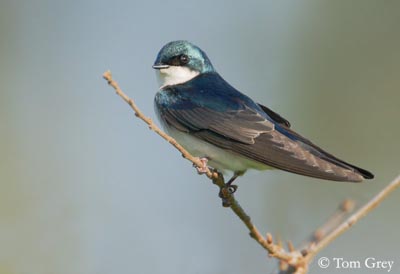
Tree Swallow
Tachycineta bicolor
Passeriforme Order – Hirundinidae Family
BIOMETRICS:
Length : 12-15 cm
Wingspan : 30-35 cm
Weight : 16-25 g
LONGIVITY: Up to 11 years
DESCRIPTION:
Tree Swallow has long wings and small legs and feet. It is iridescent greenish blue on the upperparts, and white on the underparts, chin, breast and belly. Tree Swallow has a short black bill, and dark reddish brown or brownish grey feet. Eyes are dark brown. Tail is short.
Fr: Hirondelle bicolore
All : Sumpfschwalbe
Esp : Golondrina Bicolor
Ital: Rondine arboricola bicolore
Nd: Boomzwaluw
Russe: Древесная ласточка
Sd: Trädsvala
Photographs by Tom Grey
His website: Tom Grey's Bird Pictures
Photographs by Bob Moul
His website: Nature Photography
Text by Nicole Bouglouan
Sources :
A GUIDE TO THE BIRDS OF MEXICO AND NORTHERN CENTRAL AMERICA by Steve N. G. Howell, Sophie Webb - Oxford University Press - ISBN: 0198540124
FIELD GUIDE TO THE BIRDS OF NORTH AMERICA by National Geographic Society - National Geographic Society - ISBN: 0792274512
BIRDS OF THE GREAT BASIN – by Fred A. Ryser - Univ of Nevada Pr -ISBN: 0874170796
All About Birds (Cornell Lab of Ornithology)
Animal Diversity Web (University of Michigan Museum of Zoology)
Bird Web (Seattle Audubon Society)
What Bird-The ultimate Bird Guide (Mitchell Waite)
Wikipedia (Wikipedia, The Free Encyclopedia)

Juvenile is brownish. It has a dusky wash across its white chest and belly.
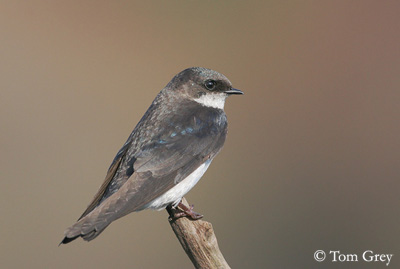
One year old female looks very similar to adult, but has a mixture of brown and iridescent greenish blue above.
Nestlings are downy, skin pale pink, down whitish, mouth pale yellow.
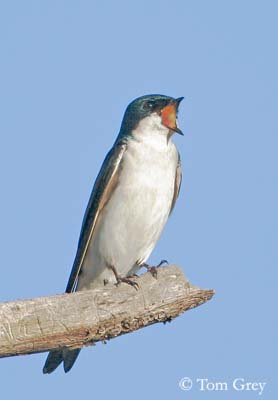
VOICE: SOUNDS BY XENO-CANTO
Contact call is a liquid, twittering “klweet”. Both sexes use calls to communicate. Fourteen different calls have been identified. They use them to signal distress, anxiety, pleasure and submission to beg for food and solicit copulation.
HABITAT:
Tree Swallow lives in open areas near water, such as fields, marshes, meadows, shorelines, ponds and wooded swamps. Tree swallow needs dead trees, or excavated holes in live trees, because it’s a cavity nester.
RANGE:
Tree Swallow breeds in Central and Northern America. It winters in southern North America, Florida, along the Caribbean coast of Central America.
BEHAVIOUR:
Outside of the breeding period, tree swallow form enormous flocks and night roosts, sometimes in the hundreds or thousands. They arrive an hour before sunset at the roost site, forming a dense cloud. They swirl around like a tornado, and when darkness approaches, they wheel low over the marsh or a grove of small trees. Large numbers drop down into the roost with each pass of the flock, until the flock disappears.
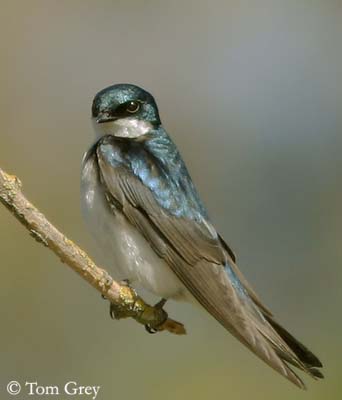
Tree Swallows are gregarious, but strongly territorial too, overall during the breeding season. Both parents defend an area around its nest.
Tree Swallow is fully migratory. They migrate during the day, often in loose flocks, and roost together in large groups at night.
Tree Swallow spends little time on the ground, preferring to perch. They spend much of their time flying and tend to glide more than other swallows. In order to bathe swallows swoop down over water. They lightly brush the water and begin to fly upwards, shaking the water off. They use rain fall as a shower, preening extensively at this time.
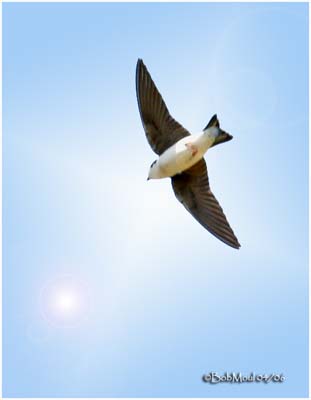
Tree Swallow eats flying insects. It forages in flight, and above open water or ground. They can forage in flocks when insects are abundant. It can glean insects from the surface of water or vertical surfaces.
Tree Swallow responds to predators by mobbing them. Large numbers of birds swarm and dive bomb while calling.
FLIGHT:
During fall and winter, Tree Swallows form migratory flocks that can contain from a few thousand to a million individuals. They are highly acrobatic and forage mostly in flight, often swooping low over open water or fields.
REPRODUCTION:
Tree Swallows raise one brood per year. They nest solitary, but they may nest near each other if the cavities are close together. Nest is built in cavity in dead or live tree, or in hollow stumps over water. It is built entirely by female. It is made of grasses, mosses, rootlets and aquatic plants, and lined with feathers from other species. Tree swallow can pulling off some feathers from duck’s back. These feathers help to keep the nestlings warm, so they can grow faster. Construction takes from a few days to two weeks.
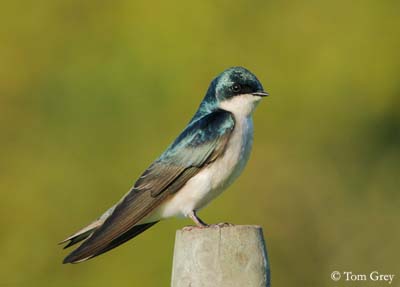
Female lays 2 to 8 white eggs, one per day. Incubation lasts about 11 to 19 days, by female. Female feeds the chicks for the first three days.
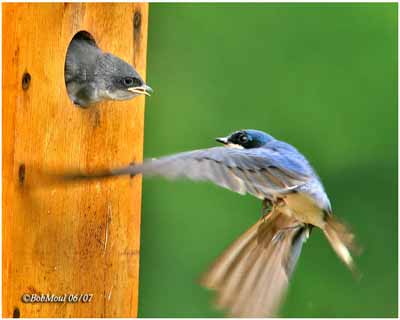
Both parents share feeding and finding food for the chicks. They fledge 15 to 20 days after hatching, and they are good fliers. Both parents feed the chicks at least 3 days more. They are able to breed when they are one year old.
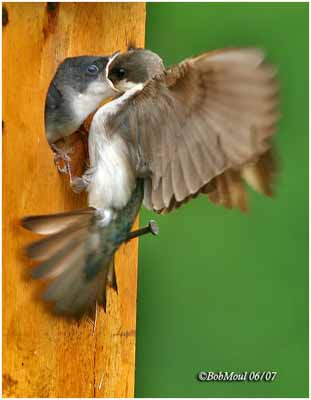
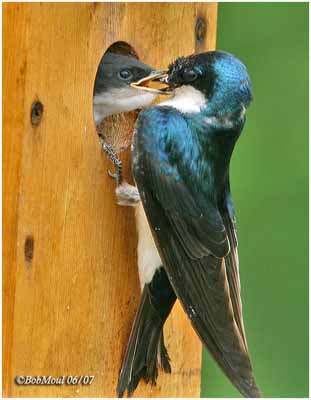
DIET:
Tree Swallow feeds primarily on flying insects, but also plant materials (20% of their diet). Insects include flies, beetles, and ants, though mayflies, caddis flies, spiders and grasshoppers are also common preys.
But when the weather is bad, Tree Swallow feeds on vegetation, including bayberries and other plants seeds.
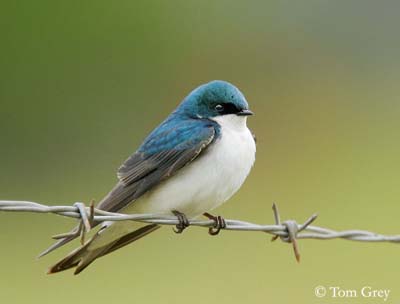
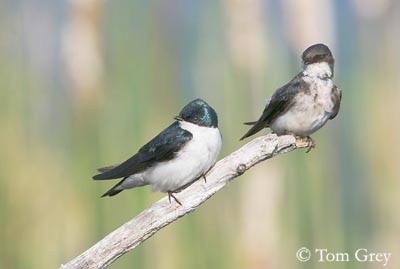
PROTECTION/ THREATS / STATUS:
Eggs and nestlings are vulnerable to predation by raccoons, black bears, raptors, small rodents and snakes. Adults are preyed upon by raptors.